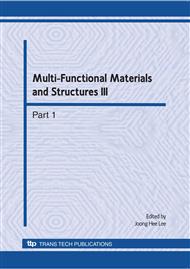p.1039
p.1043
p.1047
p.1051
p.1055
p.1059
p.1063
p.1067
p.1071
Study on the Wear-Resisting Property of Wood Cu/Ni Electroplate Coating
Abstract:
In this study, wood surface was treated in metal processing using Cu/Ni electroplate methods. The bonding force and surface morphology between metal coatings and wood pores were measured by SEM. The non-lubricated friction was tested using the MMW-1 vertical universal friction and wear testing machine. Then the waterproof performance was measured by contact angle tester. The results show that the wood still remained original pore structure after treated by copper electroplate and nickel electroplate, but the surface had been completely covered by metal coating. The dense of coating was compact and uniformly distributed, the interfacial bonding was well. After the wood treated by Cu/Ni, the friction coefficient declined from 0.04-0.12 to 0.004 and 0.003, and the friction torque decreased from 10-30N.mm to 1N.mm, at the same time the average of hardness increased from 6.42HV to 93.18HV and 226.86HV. The treated metal-wood surface has higher wear-resisting property and hardness.
Info:
Periodical:
Pages:
1055-1058
Citation:
Online since:
August 2010
Authors:
Keywords:
Price:
Сopyright:
© 2010 Trans Tech Publications Ltd. All Rights Reserved
Share:
Citation:


